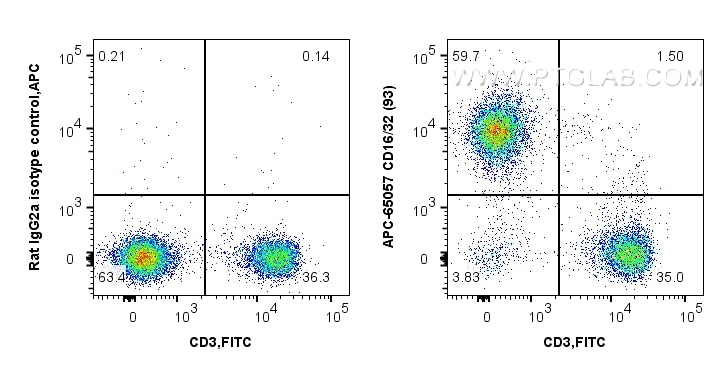CD16/CD32 Monoklonaler Antikörper
CD16/CD32 Monoklonal Antikörper für FC
Wirt / Isotyp
Ratte / IgG2a, lambda
Getestete Reaktivität
Maus
Anwendung
FC
Konjugation
APC Fluorescent Dye
CloneNo.
93
Kat-Nr. : APC-65057
Synonyme
Geprüfte Anwendungen
| Erfolgreiche Detektion in FC | Maus-Splenozyten |
Empfohlene Verdünnung
| Anwendung | Verdünnung |
|---|---|
| This reagent has been tested for flow cytometric analysis. It is recommended that this reagent should be titrated in each testing system to obtain optimal results. | |
| Sample-dependent, check data in validation data gallery | |
Produktinformation
APC-65057 bindet in FC CD16/CD32 und zeigt Reaktivität mit Maus
| Getestete Reaktivität | Maus |
| Wirt / Isotyp | Ratte / IgG2a, lambda |
| Klonalität | Monoklonal |
| Typ | Antikörper |
| Immunogen | VH81X Tg-B-Zellen und T220-Stromazelllinie |
| Vollständiger Name | Fc receptor, IgG, low affinity IIb |
| GenBank-Zugangsnummer | BC038070 |
| Gene symbol | CD16/32 |
| Gene ID (NCBI) | 14130 |
| Konjugation | APC Fluorescent Dye |
| Excitation/Emission maxima wavelengths | 650 nm / 660 nm |
| Form | Liquid |
| Reinigungsmethode | Affinitätsreinigung |
| Lagerungspuffer | PBS with 0.09% sodium azide and 0.5% BSA |
| Lagerungsbedingungen | Store at 2-8°C. Avoid exposure to light. Stable for one year after shipment. |
Hintergrundinformationen
CD16 (FcγRIII) is a 50-70 kDa low affinity Fc receptor found on the surface of natural killer cells, neutrophil polymorphonuclear leukocytes, monocytes and macrophages. CD16 mediates antibody-dependent cellular cytotoxicity (ADCC) and other antibody-dependent responses, such as phagocytosis. CD32 (FcγRII) is a 40 kD transmembrane glycoprotein that binds to the Fc region of IgG with low affinity. CD32 is present on phagocytic cells such as macrophages and neutrophils, and is involved in the process of phagocytosis and clearing of immune complexes.
Protokolle
| PRODUKTSPEZIFISCHE PROTOKOLLE | |
|---|---|
| FC protocol for APC CD16/CD32 antibody APC-65057 | Download protocol |
| STANDARD-PROTOKOLLE | |
|---|---|
| Klicken Sie hier, um unsere Standardprotokolle anzuzeigen |


